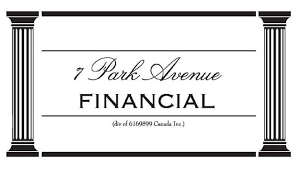|
Asset Based Lending : Financing Solutions That Match Business Reality
Asset Based Based Financing : The Growth Capital Hidden in Plain Sight
YOUR COMPANY IS LOOKING FOR A CANADIAN ASSET-BASED LINE OF CREDIT FINANCING!
UNDERSTANDING ASSET-BASED LOANS / UNSECURED LOANS IN CANADA
UPDATED 06/14/2025
You've arrived at the right address! Welcome to 7 Park Avenue Financial
Financing & Cash flow are the biggest issues facing businesses today
ARE YOU UNAWARE OR DISSATISFIED WITH YOUR CURRENT BUSINESS FINANCING OPTIONS?
CONTACT US
CALL NOW - DIRECT LINE - 416 319 5769 - Let's talk or arrange a meeting to discuss your needs
EMAIL - sprokop@7parkavenuefinancial.com

ASSET BASED LOAN SOLUTIONS IN CANADA
Money is like gasoline during a road trip . You don't want to run out of gas on your trip, but you're not doing a tour of gas stations - Tim O'Reily
Asset-based loans and asset-based lines of credit are solid solutions for Canadian business financing needs when it comes to lines of credit.
They might just be the future of business credit lines. Common asset-based borrowers come from every industry in Canadian business when it comes to the decision or need to borrow money.
Let's dig into how asset-based business credit lines via asset-based lending can help businesses grow while maximizing working capital potential.
Trapped Capital, Growing Business Needs
Your inventory sits while bills pile up. Traditional banks scrutinize credit history over asset value.
Meanwhile, growth opportunities slip away as competitors secure financing faster.
Let the 7 Park Avenue Financial team show how asset-based lending facilities unlock capital trapped in your existing assets via asset lending values on inventory, receivables, equipment, providing immediate working capital based on what you own, not just your credit profile. This financing can also refinance existing debt .
3 Uncommon Takes on Asset Based Lending Facilities
-
The "Hidden Equity Vault" Perspective: Most business owners don't realize they're sitting on a vault of accessible capital. Your accounts receivable alone might represent 30-60 days of immediate cash flow that's currently locked up, while your inventory could provide seasonal financing bridges that traditional lenders simply can't match.
-
The "Speed vs. Scrutiny" Advantage: While banks spend months analyzing your tax returns and credit history, asset based lenders focus on what they can see, touch, and verify today. This creates a financing timeline that matches business reality rather than bureaucratic processes.
-
The "Growth Enabler" Factor: Rather than viewing asset based lending as a last resort, forward-thinking business owners use these facilities as strategic growth tools, leveraging seasonal inventory builds or large receivables to fund expansion before competitors can react.
What Is an Asset-Based Business Line of Credit - How Does It Work?
An asset-based business line of credit is a method of financing employed by many businesses that allows the business to borrow against the value of business assets in the company.
Typical assets financed are accounts receivable, inventories, and fixed assets/equipment. Asset-based business lenders evaluate the value of each asset category and create an ongoing borrowing base that allows the company to draw down on the facility as cash is needed.
The business borrower only pays interest on the amount utilized under the facility.
Asset-Based Lending Is the Bank Alternative! Asset-Based Lending Solutions Versus
Traditional Bank Loans
It's an alternative to a chartered bank line of credit that offers minimal financial covenants with a focus on the company's assets.
(In some cases, the banks themselves even offer this unique financing as a subset of their services!) Typically, banks prefer more highly liquid collateral/liquid assets. At 7 Park Avenue Financial, we're unabashed supporters of 'ABL'... so... let's dig in.
How Asset-Based Lending Works
Asset-based lending should not be confused with 'loans' or 'term debt.'
It's a working capital or line of credit facility that is tied to your firm's inventory, receivables, and in some cases, physical assets such as equipment which qualify for fixed asset facility limits , and commercial real estate can be added:Allowing a company to fund payroll expenses and to cover day-to-day and short-term needs around funding operations.
These are almost always higher funding amounts than traditional operating facility advances for firms with sales and sufficient assets. Companies with marginal cash flows are solid candidates for ABL soluitons.
Fun fact? Some of Canada's largest corporations are now utilizing this type of financing.
So if some of Canada's largest corporations have abandoned traditional bank financing to obtain lines of credit, should your firm at least consider and learn more about this type of facility? The benefits are worth investigating for financial performance requirements.
Understanding the Cost of Asset-Based Financing/Interest Rates
Rates on ABL facilities in Canada vary, and you can pretty well guess the parameters of why they vary, which is simply:
-
Deal size of the facility (there is no maximum loan amount)
-
Your firm's overall credit quality, and some component of assessing what industry you are in with respect to borrower defaults
-
How your industry functions vis-à-vis profitability, seasonality, and other industry dynamics
-
We can say in general that rates on ABL facilities in Canada go from 7-9% per annum to 1½% per month, depending on most of the factors we listed above.
Overall credit quality challenges should not deter you from looking into a Canadian asset-based lending solution—for the simple reason that this type of financing focuses on assets, not overall balance sheet and income statement quality.
Simply put, your company might be currently losing money or experiencing a unique challenge, but you might find you still qualify for a very significant facility.
How Can I Benefit from ABL?
On a day-to-day basis, the most significant feature of an asset-based line of credit is the ability for you to bridge cash flow that you have tied up in inventory and receivables via a higher loan-to-value ratio for your assets compared to traditional commercial banking and financing.
Your asset-based line of credit will fluctuate based on the key elements of the ABL security, namely the accounts receivable and inventory.
A/R and inventory are typically a company's most liquid collateral based on sound management and asset turnover. The good news is that as your receivables and inventory grow, you can draw down on more funds—unlike a bank facility that might have certain caps on how much exposure the bank will take with your firm on an operating line basis.
The one aspect that you should consider in such a financing solution is additional reporting, but if you can properly account and report on receivables, inventory, etc., you should not be concerned.
Many clients tell us that some of the additional 'reporting' that comes with an asset-based credit line actually has helped them understand their business better!
Key Points - Asset-Based Credit Lines
Asset-based lending solutions are the loaning of funds utilizing the assets of a business as collateral versus a bank unsecured loan credit approval.
The more liquid collateral such as accounts receivables and inventories provide a higher borrowing margin versus physical assets such as equipment.
Businesses utilize asset-backed loans/eligible collateral to cover shortfalls in day-to-day cash flow demands and their business needs, which in some cases might revolve around the seasonality or cyclicality of the business.
Case Study
A growing electronics wholesaler in Toronto, faced a common challenge: their business was profitable, but rapid growth created cash flow gaps.
With $2.3 million in accounts receivable and $1.8 million in inventory, they needed working capital but traditional banks offered only $400,000 based on cash flow.
7 Park Avenue Financial originated an asset based lending facility that provided $2.8 million in revolving credit—85% against receivables and 65% against inventory. Within three weeks the company had the working capital to fulfill a $1.2 million seasonal order that competitors couldn't match.
KEY TAKEAWAYS
- Asset Evaluation Process: Understanding how lenders assess your collateral value determines your borrowing capacity and shapes your financing strategy
- Advance Rate Structures: Knowing typical advance rates (70-85% for receivables, 50-80% for inventory) helps you calculate available funding
- Borrowing Base Calculations: These determine your credit limit based on eligible assets and directly impact your available working capital
- Reporting Requirements: Regular asset reporting maintains your credit facility and ensures continued access to funds
- Interest Rate Components: Base rates plus margins affect your total cost and should be compared across multiple lenders
Conclusion - Getting Cash Flowing Smoothly Without Traditional Lending Barriers
Looking for liquidity, working capital and cash flow, and a solution that is non-bank in nature?
Call 7 Park Avenue Financial, an expert in the area of growth financing funding.
Determine if this financing meets your needs for credit availability, and ensure, with the help of a trusted, credible, and experienced Canadian business financing advisor, that you can access the type of facility that provides you with working capital and growth opportunities into domestic and global markets in a manner that suits your company's cash cycle.
Obtaining comprehensive financial solutions for your business needs is our focus.
FAQ: Frequently Asked Questions/More Information
What is asset-based lending?
Asset-based lending is a type of financing that uses the borrower's value of the assets as collateral—and they are an alternative to term loans. Non-bank commercial lenders can approve flexible financing loans by providing higher advance rates using the physical assets of a company as collateral if they don't have enough cash assets. This type of financing is for businesses, not consumers, and provides operational flexibility to funding needs.
Small, mid-sized businesses and large corporations utilize asset-based lending. A lender may loan up to 90% of the face value of a security if it is highly marketable, such as eligible accounts receivable, and only 60% for other less liquid assets such as real estate. Advances vary based on the type of asset. ABL has a 'covenant-light structure' as opposed to a focus on only historical and present cash flows. The maximum loan for a physical asset is less than the book value of the assets.
What are the benefits of using an asset-based business line of credit over traditional bank loans?
The main benefit of the asset-based business line of credit is that qualification for approval is easier than lending via financial institutions such as traditional bank loans. Also, if a business does not have the credit history required by bank underwriting policies, the asset-backed credit line is more flexible financing with fewer restrictions than those of banks, which will often insist on personal guarantees, external collateral, high business and personal credit scores, etc. There is also typically no restriction on how funds are used with an asset-based credit line. The ability of a business to access more working capital for business operations and growth opportunities provides alternative financing options that historically were not available to the business borrower.
How do I qualify for an asset-based business line of credit?
To qualify for an asset-based business line of credit, a company should be prepared to provide proper financial statements that reflect the assets of the business on the balance sheet, such as receivables, inventory, and property, plant, and equipment. Business lenders will evaluate the pledged asset/assets and lend on the ability of the company to generate sales with proper asset turnover so as to meet repayment terms/fluctuations under the revolving line of credit.
What are the risks of using an asset-based business line of credit?
One of the main risks of using an asset-based business line of credit is that if a business defaults on the credit facility and is unable to repay the facility on a lender's demand, assets are sold by the lender to recover the loan or line of credit. Asset-based lending solutions are always higher (but not always) when it comes to interest rates and financing costs.
How can I decide if an asset-based business line of credit is right for my business?
To decide if asset-based business lines of credit are the right financing solution for a business, the business owner should evaluate the business's cash flow and financing requirements. When the amount of business capital needed is not available from traditional lenders such as banks, the benefits of ABL solutions will typically outweigh the alternative to self-financing despite higher costs of borrowing. Business owners should speak to a reputable business financing advisor to help with due diligence and ensure proper business finance decisions and optimal finance structure is attained.
Citations
- Business Development Bank of Canada. (2024). "Alternative Financing for Canadian SMEs." BDC Special Report on Business Financing. https://www.bdc.ca
- Canadian Federation of Independent Business. (2024). "Small Business Financing Challenges in Canada." CFIB Quarterly Business Barometer. https://www.cfib-fcei.ca
- Statistics Canada. (2024). "Business Credit Conditions Survey." Business Financing and Growth Report. https://www.statcan.gc.ca
- Commercial Finance Association. (2024). "Asset-Based Lending Market Trends." Annual Industry Survey Report. https://www.cfa.com
- Export Development Canada. (2024). "Working Capital Solutions for Canadian Exporters." Trade Finance Quarterly. https://www.edc.ca

' Canadian Business Financing With The Intelligent Use Of Experience '
STAN PROKOP
7 Park Avenue Financial/Copyright/2025

ABOUT THE AUTHOR: Stan Prokop is the founder of 7 Park Avenue Financial and a recognized expert on Canadian Business Financing. Since 2004 Stan has helped hundreds of small, medium and large organizations achieve the financing they need to survive and grow. He has decades of credit and lending experience working for firms such as Hewlett Packard / Cable & Wireless / Ashland Oil
|